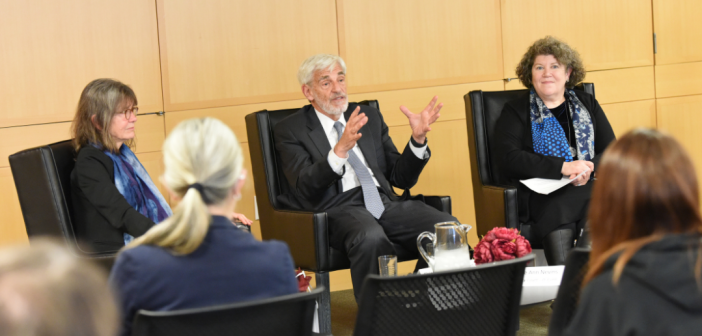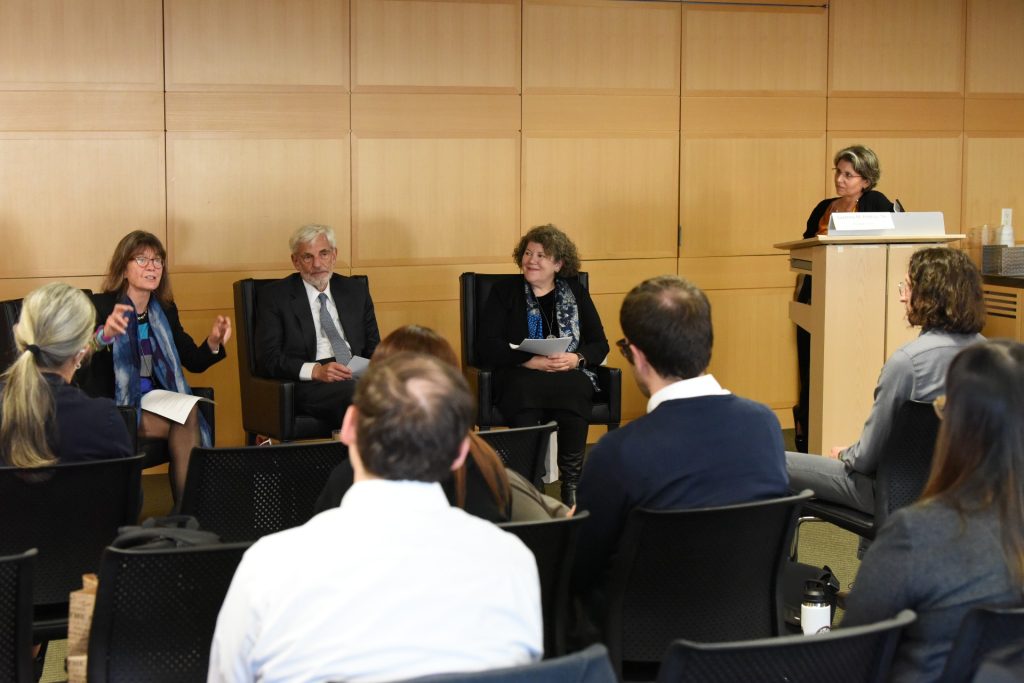On Nov. 2, the Center for Judicial Events & Clerkships (CJEC) hosted a View from Chambers focusing on federal bankruptcy court. The View from Chambers series is part of the CJEC’s Judicial Engagement through Education Initiative, shining a spotlight on a diverse slate of judges from a range of courts on the federal and state levels.
Returning to an in-person format for the first time since February 2020, the CJEC crafted this event as a panel, moderated by CJEC Assistant Dean Suzanne M. Endrizzi ’96, featuring three distinguished bankruptcy judges from nearby districts. The participating judges included Chief Judge Martin Glenn of the Southern District of New York, Chief Judge Ann Nevins of the District of Connecticut, and Judge Elizabeth Stong of the Eastern District of New York.
The panel format allowed for the Article I judges to not only provide an overview of the bankruptcy court—including where the court’s powers come from and goals of the court’s work—but to also highlight the differences in dockets among the districts. The judges also shared with the attendees their varied paths to the bench.
Immediately after the panel the attendees and judges mingled and chatted informally over sweets and hot cocoa.
“The bankruptcy court docket is incredibly varied and the court’s work is so important to individuals and businesses,” said Endrizzi. “We were fortunate to have judges with such diverse dockets allowing for such a rich discussion.”
A Glimpse into Their Dockets
As each of the judges noted, the issues that they hear in court vary, resulting in interesting and unique dockets. Initially the judges spoke generally about the types of bankruptcies that arise under Chapters 7, 11, 12, 13 and 15 and how each chapter differs with respect to larger and small businesses as well as individuals. The discussion later turned toward emerging trends in bankruptcy.
“Some of the newer, larger cases are related to opioids … but three large cases in the Southern District of New York deal with cryptocurrency,” said Chief Judge Glenn, who was presiding over two of those crypto-related cases—including the one with crypto lender Celsius Network—at the time of the event. “I didn’t know a whole lot about cryptocurrency before this case and it still is very much of a learning process. What is it? Where is it? … We keep learning [something new]every day.”
Judge Nevins shared interesting examples of cases she has presided over, demonstrating the range of issues that can arise in consumer bankruptcy cases. “One Chapter 12 case I had [that lasted three weeks]was about cows on a farm in Northern Connecticut,” she said. “[The two parties] wanted to know whose cows were whose. The post-bankruptcy lender needed to know in case of an eventual liquidation of its collateral (i.e., the cows).”
“I learned all about the tagging of livestock, which as it turns out is quite advanced with GPS tagging and does more than your Apple Watch,” Judge Nevins continued. “The compromise was [implementing]two different GPS systems—one lender had ear tags on the cows and the other lender had bracelets that went around their ankles.”
Judge Stong also spoke at length about the goal of the court’s work in adjudicating various claims, referring to the court as the “problem-solving, second-chance court.” “We’re a court that ideally helps a company figure out how they can pay their workers next month and that helps the family who got behind in their mortgage,” she said. “If you’re thinking about a transparent process that’s responsive to the needs of the parties, is forward looking, and is focused on value preservation and value creation, then you have a pretty good sense of what we do. It’s part of our job—together with our colleagues, law clerks, and interns—to be ready for that and to do our best.”
“I liked the concept that bankruptcy court is one of second chances and redemption,” said Afrika Owes ’23 after attending the event. “I wasn’t expecting to hear that perspective, so it was a welcome surprise. I’m glad I attended because it gave me insight into a new area of law.”
Stephanie Diu ’23, who also attended the panel, was not familiar with the bankruptcy court system beforehand. “I loved hearing the judges speak passionately about their work, about how bankruptcy can repair lives and offer relief to people, and about some interesting proceedings they were involved in,” said Diu. “I don’t know if I will pursue bankruptcy work after I graduate, but I hope to find a practice area that brings me as much joy as bankruptcy brings to the judges I met at the event.”
“The View from Chambers can broaden the horizons of our students, enabling them to engage and understand the role of courts beyond those typically encountered in their casebooks and classrooms,” said James J. Brudney, Joseph Crowley Chair in Labor and Employment Law and CJEC Faculty Director. “These three bankruptcy judges—through their insights, reflections and enthusiasm—served as a wonderful example of that broadening process.”







